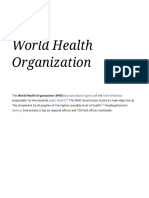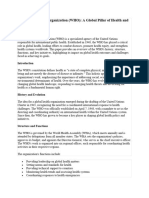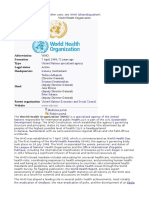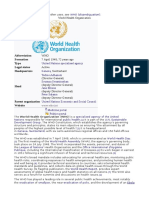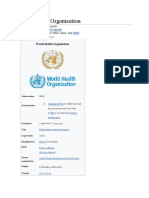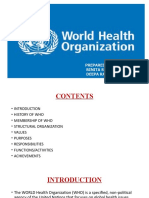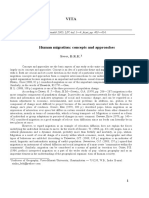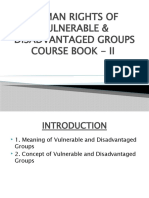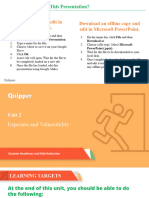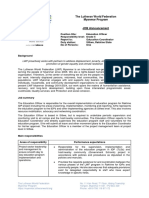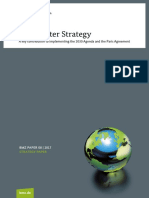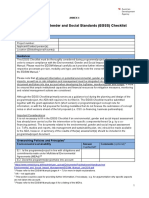NVMUN 9.
BACKGROUND
GUIDE
WORLD HEALTH
ORGANIZATION
AGENDA- Ensuring Equitable Healthcare and Vaccine Access for Marginalized and
Displaced Communities
1
WHO
� NVMUN 9.0
LETTER FROM THE EXECUTIVE BOARD-
Dear Delegates,
It is our utmost pleasure to welcome you to the World Health Organization at NVMUN. As your
Chairperson and Vice Chairperson, we are truly honoured to facilitate what promises to be an
intellectually rich and globally relevant discussion on the agenda: “Ensuring Equitable
Healthcare and Vaccine Access for Marginalized and Displaced Communities.”
This issue lies at the heart of global public health and humanitarian justice. While great strides
have been made in advancing medical science and healthcare delivery over the past decades,
these achievements remain unevenly distributed. For the world’s 110 million displaced persons,
including refugees, internally displaced people (IDPs), stateless individuals, and migrants, access
to healthcare remains not only difficult but, in many cases, entirely inaccessible. Crises such as
the COVID-19 pandemic have magnified the deep fractures in our global health infrastructure.
They have revealed how political instability, poverty, systemic discrimination, and lack of
documentation continue to leave millions without the most basic healthcare or life-saving
vaccines.
Our committee will address not just the logistics of distribution, but the larger ethical, legal, and
social questions that determine who gets access and who gets left behind. Whether we are
speaking about Rohingya refugees in Bangladesh, war-affected civilians in Syria, or underserved
populations in sub-Saharan Africa affected by HIV, the reality is that no nation or institution can
address these challenges alone. International cooperation, innovation, and moral clarity are
needed now more than ever.
2
WHO
� NVMUN 9.0
As delegates, you hold the responsibility and the opportunity to reimagine a global health
landscape that is truly inclusive. We urge you to approach the debate with intellectual curiosity,
evidence-based thinking, and above all, empathy. Understand that every statistic in your research
reflects a human life: a child without vaccines, a mother unable to access prenatal care, a
community without clinics.
Throughout this conference, we hope you will engage deeply with the nuances of this issue.
Consider the balance between state sovereignty and humanitarian intervention, the role of
international organizations like WHO and UNHCR, the impact of public-private partnerships,
and the potential of technological innovation to overcome access barriers. Explore the structural
inequalities that persist even within aid systems, and think critically about how health can be
made not just available, but equitable.
Ultimately, this committee is more than a simulation, it is a space to build the future you wish to
see. We are immensely excited to hear your diverse perspectives, policy proposals, and solutions.
We are confident that your dedication will lead to a thoughtful and transformative discussion.
Best of luck, and may your voices echo far beyond the committee room.
Warm regards,
Mihir Kulkarni
Chairperson, WHO
Reyansh Machhar
Vice Chairperson, WHO
3
WHO
� NVMUN 9.0
TABLE OF CONTENTS
1. Introduction to committee……………………………………………5
2. 3.Mandate of committee……………………………………………..7
3. 4.Introduction to the Agenda………………………………………...9
4. Background of the Agenda………………………………………….11
5. Key Stakeholders……………………………………………………16
6. Past Resolutions…………………………………………………….18
7. Suggestions…………………………………………………………20
8. Bibliography………………………………………………………..21
4
WHO
� NVMUN 9.0
INTRODUCTION TO THE COMMITTEE
The World Health Organization (WHO) is the United Nations' specialized agency for
international public health. It was officially established on April 7, 1948, a date now celebrated
annually as World Health Day, with the mission of ensuring the highest possible standard of
health for all people, regardless of nationality, socioeconomic status, or geographic location.
WHO’s Constitution, adopted in 1946, defines health as a state of complete physical, mental, and
social well-being not merely the absence of disease or infirmity reflecting its holistic and
inclusive approach to public health.
With 194 Member States, WHO works across six key areas: strengthening national health
systems, promoting lifelong health and well-being, addressing communicable and non-
communicable diseases, enhancing emergency preparedness and response, setting international
health standards, and coordinating partnerships with governments, civil society, and the private
sector. The organization’s work spans the development of health policies and guidelines,
technical assistance, disease surveillance, and direct interventions in crisis situations.
One of WHO’s most notable achievements was the successful global eradication of smallpox in
1980, following a decades-long immunization campaign. Another milestone was the Alma-Ata
Declaration of 1978, which emphasized the importance of primary healthcare and linked health
to social and economic development. These efforts laid the foundation for WHO’s long-term
goal of achieving universal health coverage and reducing global health disparities.
WHO is governed by the World Health Assembly (WHA) its decision-making body composed
of representatives from all Member States and the Executive Board, which consists of 34 health
5
WHO
� NVMUN 9.0
experts nominated by Member States and elected by the Assembly. The WHA meets annually to
set policies, approve budgets, and appoint the Director-General, who serves as WHO’s chief
technical and administrative officer. The Executive Board meets at least twice a year to
implement WHA decisions and provide oversight, especially during health emergencies.
The Director-General, supported by WHO’s Secretariat in Geneva and a decentralized network
of regional and country offices, leads the organization’s strategic and operational efforts. WHO
currently maintains six regional offices and more than 150 country and liaison offices
worldwide, enabling it to respond effectively to both local and global health challenges.
WHO’s funding is drawn from two main sources: assessed contributions, which are mandatory
dues paid by Member States, and voluntary contributions, which are provided by governments,
international organizations, NGOs, and the private sector. Over the years, voluntary
contributions have significantly outpaced assessed ones, prompting reforms to ensure transparent
and balanced financing. In 2011, WHO launched a Member State-led reform process to enhance
the organization’s efficiency, governance, and accountability. This reform focuses on priority-
setting, program management, and governance structures to make WHO more responsive to
emerging global health needs.
In the 21st century, WHO continues to play a central role in global health governance,
particularly in managing international responses to health emergencies such as the Ebola
outbreak, the COVID-19 pandemic, and humanitarian crises affecting displaced populations. It
collaborates with other UN bodies like UNICEF, UNHCR, GAVI, and the Global Fund, as well
as civil society, to ensure inclusive and coordinated efforts in advancing global health.
This committee, under the WHO framework, will focus on one of the most pressing and complex
challenges of our time: ensuring equitable access to healthcare and vaccines for marginalized and
displaced communities. Through diplomatic negotiation, policy formulation, and critical
analysis, delegates will examine how WHO can further its mission of “Health for All” by
addressing systemic barriers and promoting inclusive healthcare delivery on a global scale.
6
WHO
� NVMUN 9.0
MANDATE OF THE COMMITTEE
The World Health Organization (WHO) serves as the primary international authority on public
health under the United Nations, with a legally binding mandate established by its Constitution
adopted in 1946 and effective from 1948. The WHO’s mandate outlines its responsibility to act
as the directing and coordinating body for health matters globally, aiming to achieve the highest
possible level of health for all people, regardless of geography, nationality, or socio-economic
status.
The committee’s mandate includes:
1. Health Policy Leadership and Standard Setting:
WHO develops international health standards, norms, and guidelines, including
protocols for disease prevention, health promotion, and treatment. This includes
formulating global policies for vaccination, communicable and non-communicable
diseases, and health emergencies.
2. Coordination of International Health Responses:
In times of public health crises—such as pandemics, outbreaks, and natural disasters—
WHO is mandated to coordinate multi-country responses, provide technical guidance,
and facilitate resource mobilization. This role is crucial to ensuring an effective and
timely global response.
3. Technical Assistance and Capacity Building:
WHO provides expertise and support to member states, especially low- and middle-
7
WHO
� NVMUN 9.0
income countries, to strengthen national health systems. This includes training healthcare
workers, improving infrastructure, and enhancing disease surveillance and reporting
mechanisms.
4. Promotion of Health Equity:
A central part of WHO’s mandate is to reduce health disparities, particularly among
marginalized and vulnerable groups, including refugees, internally displaced persons
(IDPs), migrants, and stateless populations. WHO is tasked with ensuring that health
policies and programs are inclusive and address barriers such as discrimination, lack of
access, and political instability.
5. Facilitation of Equitable Access to Medicines and Vaccines:
WHO is responsible for promoting fair and equitable access to essential medicines and
vaccines worldwide, advocating for initiatives such as the COVAX facility, and ensuring
distribution mechanisms reach underserved and displaced communities.
6. Health Data Collection and Research:
The committee is mandated to gather, analyze, and disseminate health data globally. This
evidence-based approach helps inform policies and interventions tailored to emerging and
ongoing health challenges.
7. Collaboration with Other International Bodies:
WHO works closely with other UN agencies like UNICEF, UNHCR, and the Global
Fund, as well as non-governmental organizations (NGOs) and governments, to coordinate
health programs for vulnerable populations. This inter-agency collaboration is vital to
addressing complex health needs in displaced and marginalized communities.
8. The WHO’s mandate empowers it to set the agenda and mobilize the international
community to address global health challenges. In this committee, delegates will explore
how WHO can effectively fulfill these responsibilities, especially in ensuring equitable
healthcare and vaccine access for marginalized and displaced populations, while
navigating political, economic, and logistical obstacles.
8
WHO
� NVMUN 9.0
9. This mandate aligns with the broader objectives of the United Nations Sustainable
Development Goals (SDGs), particularly SDG 3, which calls for universal health
coverage and access to quality essential healthcare services.
INTRODUCTION TO THE AGENDA-
The agenda, “Ensuring Equitable Healthcare and Vaccine Access for Marginalized and
Displaced Communities,” centers on reducing disparities in the availability, affordability, and
quality of healthcare and vaccines for vulnerable populations. Marginalized communities include
groups systematically excluded from full participation in society due to factors such as ethnicity,
legal status, gender identity, disability, or socioeconomic conditions. Displaced communities
refer to refugees, internally displaced persons (IDPs), migrants, and stateless individuals who are
forced to flee their homes due to conflict, persecution, or natural disasters.
Ensuring equitable healthcare means guaranteeing fair and just access to essential medical
services and vaccinations for these populations—regardless of their location, identity, or legal
status. Such efforts are vital to promote public health, prevent disease outbreaks, and uphold the
universal right to health.
Globally, 2.1 billion people lack access to essential health services (WHO, 2021). Among them
are over 120 million forcibly displaced individuals, including 43.3 million IDPs, 36.4 million
refugees, and 5.3 million asylum seekers(UNHCR, 2024). These populations face compounded
barriers such as legal exclusion, linguistic and cultural differences, discrimination, and
geographic isolation. The WHO reports that marginalized communities are up to four times more
likely to experience severe health outcomes than the general population due to structural
inequalities (WHO, 2020).
9
WHO
� NVMUN 9.0
The COVID-19 pandemic sharply exposed these inequities. While many high-income nations
reached vaccination coverage exceeding 80%, underserved and displaced populations lagged far
behind—some refugee-hosting regions reported coverage as low as 5–10% during critical rollout
phases (Gavi, 2022). Additionally, only 48% of humanitarian health response plans were fully
funded in 2023, severely limiting access to maternal care, infectious disease prevention, and
essential medicines in crisis regions (OCHA, 2024).
In this context, this agenda highlights not just a humanitarian obligation but a global health
security imperative. Ensuring healthcare and vaccines for marginalized and displaced
communities is essential to preventing disease outbreaks, safeguarding global stability, and
fulfilling Sustainable Development Goal 3: Good Health and Well-Being.Link to
Sustainable Development Goal 3: Good Health and Well-Being
SDG 3—“Ensure healthy lives and promote well-being for all at all ages”—directly aligns
with this agenda. It prioritizes universal health coverage, access to safe, affordable, and quality
healthcare services, and the reduction of health inequalities. However, the world is currently off-
track to achieve SDG 3.
Although progress has been made—life expectancy has risen, maternal and infant mortality rates
have declined, and deaths from HIV and malaria have been reduced by half—these advances are
uneven. There remains a 31-year gap in life expectancy between the world's shortest- and
longest-living populations. National averages mask the stark inequalities faced by vulnerable
groups such as refugees, the stateless, and ethnic minorities.
The 2030 Agenda recognizes that good health is fundamental to sustainable development. It
addresses not only traditional health burdens but also rising challenges like noncommunicable
diseases, climate-related health threats, and systemic inequalities. Achieving SDG 3 will require
rights-based, multisectoral, and inclusive approaches that prioritize the needs of the most
vulnerable.
Without targeted action for marginalized and displaced communities, global goals for health and
well-being cannot be met. Equity must be at the heart of all public health responses.
10
WHO
� NVMUN 9.0
BACKGROUND OF THE AGENDA
The issue of unequal healthcare access for marginalized and displaced communities has deep
historical roots. Throughout modern history, vulnerable populations—such as refugees,
internally displaced persons (IDPs), migrants, and stateless people—have faced systematic
barriers to health services due to discrimination, poverty, conflict, or legal exclusion. After
World War II, millions of people were displaced across Europe, sparking international
discussions about refugee rights and humanitarian health. However, it wasn’t until the formation
of the World Health Organization (WHO) in 1948 and the United Nations High Commissioner
for Refugees (UNHCR) in 1950 that coordinated global action began to emerge around
providing healthcare to displaced and marginalized groups. Even then, access to quality care
remained fragmented and inconsistent, depending heavily on country policies, funding, and
political will.
As mentioned before, Globally, 2.1 billion people lack access to essential health services (WHO,
2021). Among them are over 120 million forcibly displaced individuals, including 43.3 million
IDPs, 36.4 million refugees, and 5.3 million asylum seekers(UNHCR, 2024). These populations
face compounded barriers such as legal exclusion, linguistic and cultural differences,
discrimination, and geographic isolation. The WHO reports that marginalized communities are
up to four times more likely to experience severe health outcomes than the general population
due to structural inequalities (WHO, 2020).
11
WHO
� NVMUN 9.0
Major global health crises over the past few decades have exposed these disparities more clearly.
Here are some case studies that will help you to understand the situation.-
Case Study 1: HIV/AIDS and Marginalized Populations
Background-
Since its discovery in the early 1980s, HIV/AIDS has disproportionately affected marginalized
populations, including sex workers, transgender individuals, intravenous drug users, and people
living in poverty or without stable housing.In 2023, UNAIDS reported that globally,
approximately 39.9 million people were living with HIV, with 1.3 million new infections and
630,000 AIDS-related deaths that year. Since the start of the epidemic, around 88.4 million
people have acquired HIV, and 42.3 million have died from AIDS-related illnesses. Women and
girls accounted for 53% of those living with HIV, 44% of new HIV infections.
Challenges in Healthcare Access-
Stigma and discrimination remain among the largest barriers to equitable care. A 2021 UNAIDS
report revealed that nearly 60% of key populations had experienced discrimination in healthcare
settings, leading many to avoid testing or treatment. For example, transgender individuals in
Southeast Asia and Africa frequently report being denied care or subjected to abuse in medical
settings.
Sub-Saharan Africa, a region where approximately 67% of the world's population living with
HIV reside, faces significant challenges in addressing the HIV/AIDS epidemic. These include
high rates of new infections, a substantial burden of AIDS-related deaths, and the need for wider
access to treatment and care, particularly antiretroviral therapy. Structural inequities such as poor
infrastructure, gender-based violence, and economic dependency significantly hinder treatment
adherence and care access. Among displaced populations, these challenges multiply. Refugees in
South Sudan, for example, experience limited access to antiretroviral therapy (ART), which is
essential for managing HIV.
12
WHO
� NVMUN 9.0
Efforts and Gaps-
The Global Fund, PEPFAR, and UNAIDS have provided substantial funding and programmatic
support, expanding ART access and community-based outreach. However, many interventions
are urban-centered and do not adequately reach rural, mobile, or displaced populations. Mobile
clinics and peer-led education programs are emerging as promising approaches, but they remain
underfunded.
Case Study 2: The Syrian Conflict and Internally Displaced Persons (IDPs)
Background-
Since the onset of the Syrian civil war in 2011, more than 12 million Syrians have been forcibly
displaced—6.8 million internally and 5.3 million as refugees in neighboring countries like
Lebanon, Turkey, and Jordan. The healthcare system, once relatively robust, has been severely
damaged, with over 50% of medical infrastructure rendered nonfunctional and many healthcare
workers having fled.
Barriers to Healthcare Access-
IDPs and civilians in non-government-controlled areas face near-complete isolation from
healthcare services. Access to chronic disease treatment, maternal care, and vaccinations has
been drastically curtailed. According to the WHO, polio re-emerged in Syria in 2013 after years
of eradication due to disrupted immunization campaigns in war zones.
Furthermore, cross-border humanitarian aid delivery has become highly politicized. In July 2022,
the UN Security Council was forced to negotiate the extension of a cross-border aid mechanism
after concerns from the Syrian government about sovereignty. This jeopardized consistent
vaccine delivery and medical supply chains to rebel-held areas like Idlib.
Efforts and Gaps-
13
WHO
� NVMUN 9.0
International NGOs like Médecins Sans Frontières and Syrian diaspora medical networks have
stepped in, but funding volatility and safety risks restrict operations. Primary care and emergency
medicine are prioritized, but mental health and chronic illness care remain under-addressed.
Case Study 3: The Rohingya Crisis in Bangladesh
Background-
Since 2017, a significant number of Rohingya Muslims, exceeding 740,000, have fled
persecution in Myanmar's Rakhine State, seeking refuge in Bangladesh's Cox's Bazar district.
This influx has resulted in the creation of the world's largest refugee settlement, where
approximately 1 million people are living in densely packed and substandard conditions. One of
the largest of these camps is Kutupalong refugee camp.
Healthcare Situation-
Rohingya refugees in Bangladesh face significant challenges in accessing healthcare due to their
stateless status, limited legal rights, and strained resources. While humanitarian organizations
provide primary care, access to specialized or secondary care remains limited, and maternal and
child health indicators are a concern. The Inter Sector Coordination Group (IACG) coordinates
these efforts, but resources are severely strained, and the situation is exacerbated by the lack of
sufficient space for sanitation and hygiene facilities. WHO reported a maternal mortality ratio of
179 per 100,000 live births among the Rohingya in 2022,higher than national averages.
Vaccination and Epidemic Response-
Due to crowded and unsanitary conditions, disease outbreaks are frequent. A major diphtheria
outbreak in 2017 affected over 8,000 individuals, mainly children. Cholera and measles also
remain persistent threats. Despite multiple oral cholera and COVID-19 vaccination drives,
community mistrust, logistical constraints, and language barriers continue to limit full coverage.
Efforts and Gaps-
14
WHO
� NVMUN 9.0
While WHO and Gavi have collaborated on mass immunization campaigns, these are often
reactive rather than preventive. Sustainable health infrastructure and long-term care planning
remain absent due to the “temporary” classification of the camps by the host government.
Case Study 4: COVID-19 and Global Vaccine Inequity
Background-
The COVID-19 pandemic exposed stark inequities in global healthcare systems, particularly in
vaccine distribution. While high-income countries vaccinated large portions of their populations
rapidly, low-income countries and displaced communities were left behind.
By the end of 2021, over 70% of people in high-income countries had received at least one
vaccine dose, compared to less than 10% in many low-income nations (NCBI). Marginalized
groups within countries—including indigenous communities, rural poor, and migrants—also saw
lower vaccination rates due to digital exclusion, mistrust, and lack of tailored outreach.
For example, in Latin America, indigenous groups in the Amazon basin had limited access to
vaccines due to the absence of cold-chain infrastructure and political neglect. In Lebanon,
COVID-19 vaccination campaigns struggled to reach over 1.5 million refugees and migrants,
despite WHO-supported mobile outreach.
Global Mechanisms and Limitations-
COVAX, co-led by Gavi, WHO, and CEPI, was launched to ensure equitable vaccine access.
However, as of 2022, it faced criticism for delivering fewer doses than pledged due to supply
chain delays and wealthy nations stockpiling vaccines. Additionally, intellectual property
restrictions and lack of technology transfer prevented local manufacturing in many developing
countries.
15
WHO
� NVMUN 9.0
Consequences and Lessons-
The unequal vaccine rollout led to prolonged pandemic waves in underserved areas, exacerbating
mortality and economic hardship. It also increased the risk of new variants emerging in
unvaccinated populations. Experts have emphasized the need for future pandemic preparedness
to prioritize equity from the outset.
KEY STAKEHOLDERS
United States of America-
The United States is the largest donor to the World Health Organization and other health
programs, including Gavi (the Vaccine Alliance), UNICEF, and the Global Fund. During the
COVID-19 pandemic, the United States played a key role in COVAX, the global initiative aimed
at ensuring equitable vaccine access. It has actively supported the legal inclusion of refugees and
migrants in national healthcare systems and funds mobile clinics and humanitarian health teams.
It has also focused on fighting misinformation and funding cold chain logistics to improve
vaccine outreach in conflict-affected and low-resource areas.
However,The US has left the World Health Organization (WHO). President Donald Trump
initiated the withdrawal process in 2020 and again in 2025, and it is currently set to be finalized
on January 22, 2026,
United Kingdom-
16
WHO
� NVMUN 9.0
The UK has been a leader in health diplomacy and emergency global health funding through its
Foreign, Commonwealth & Development Office (FCDO). It actively supported WHO campaigns
among displaced populations, particularly in Syria, Yemen, and certain parts of sub-Saharan
Africa. During the pandemic, the UK used its position on the UN Security Council to call for
temporary ceasefires to help with vaccine delivery in conflict zones.
The UK also promotes public-private partnerships and supports culturally inclusive health
messaging for migrants and refugees.
France-
France closely ties its foreign health policy to the Sustainable Development Goals (SDG 3 & 10)
while focusing on health equity and reducing inequalities. France funds WHO field operations in
Francophone Africa and provides logistical support for mobile health units and vaccine delivery
in displacement camps.
France emphasizes a data-driven approach, supports training for community health workers, and
promotes multilingual communication in vaccine education and delivery.
Russia-
Russia engages in global health through bilateral assistance, especially in countries it has strong
diplomatic ties with, such as Syria, Ukraine, and Central Asia. It has sent medical teams and
supported humanitarian corridors to allow vaccine access in conflict areas.
Russia advocates for vaccine sovereignty, promoting the use of its domestically produced
vaccine (Sputnik V) and encouraging solutions at the national level. Within WHO discussions,
Russia supports including displaced persons in health monitoring while emphasizing respect for
state sovereignty.
17
WHO
� NVMUN 9.0
China-
China plays a vital role in South-South cooperation by exporting vaccines, personal protective
equipment (PPE), and medical teams to lower-income countries, especially across Asia, Africa,
and Latin America. During the COVID-19 crisis, China exported or donated over 1.9 billion
vaccine doses and helped improve cold-chain infrastructure in countries housing displaced
populations.
In WHO negotiations, China supports consensus-driven solutions and advocates for fair vaccine
distribution without political interference. It also funds health programs for refugees and
migrants through multilateral channels.
PAST RESOLUTIONS
Over the years, the United Nations and the World Health Organization (WHO) have passed
several key resolutions addressing healthcare access for marginalized and displaced populations.
These resolutions lay the foundation for current international efforts to achieve equitable
healthcare and vaccine distribution.
1. World Health Assembly Resolution WHA61.17 (2008): Health of Migrants-
This resolution urged Member States to promote the health of migrants through migrant-sensitive
health policies and equitable access to healthcare. It also emphasized international cooperation to
improve health outcomes for migrants, regardless of their legal status. The resolution called for
better data collection and health system responsiveness to migrant-specific challenges.
2. World Health Assembly Resolution WHA 70.15 (2017): Promoting the Health of Refugees
and Migrants-
This resolution was built upon WHA61.17, calling for a global action plan to address the health
needs of refugees and migrants. It highlighted the importance of mainstreaming refugee and
18
WHO
� NVMUN 9.0
migrant health into national health policies, ensuring non-discriminatory access to healthcare
services, and improving the social determinants of health for displaced populations.
3. United Nations General Assembly Resolution A/RES/74/306 (2020): Comprehensive and
Coordinated Response to the COVID-19 Pandemic-
Adopted during the height of the COVID-19 pandemic, this resolution called for global solidarity
in ensuring universal, timely, and equitable access to quality, affordable diagnostics,
therapeutics, and vaccines. It emphasized that displaced and marginalized populations must not
be left behind in pandemic response efforts.
4. World Health Assembly Resolution WHA74.14 (2021): Strengthening WHO Preparedness
for and Response to Health Emergencies-
This resolution stressed the need to build inclusive and resilient health systems that prioritize
vulnerable populations during emergencies. It recognized the disproportionate impact of
pandemics on marginalized communities and called for integrated responses, including equitable
vaccine distribution.
5. Global Compact on Refugees (UNHCR, 2018) – Health Provisions-
Although not a WHO resolution, the Global Compact on Refugees includes important
commitments to ensure access to national health systems for refugees and host communities. It
highlights the importance of providing mental health, maternal care, and vaccination services in
refugee settings.
6. World Health Assembly Resolution WHA75.6 (2022): Health Emergency Preparedness and
Response – Learning from COVID-19-
This resolution called for lessons learned from COVID-19 to be applied in future global health
emergency planning. It underscored the critical importance of reaching the most vulnerable—
including displaced and stateless populations—with vaccines and essential health services
19
WHO
� NVMUN 9.0
SUGGESTIONS
Moderated Caucas Topics:
1. The role of host governments in integrating refugees into national healthcare systems
2. Strategies to eliminate legal and documentation barriers to healthcare for displaced
individuals
3. Addressing vaccine hesitancy and mistrust among marginalized communities
4. Mental health access for refugees and stateless persons in post-conflict settings
5. The impact of humanitarian funding gaps on vaccine and healthcare access
6. Public-private partnerships to expand mobile and remote healthcare services in refugee
camps
7. Ethical implications of vaccine nationalism during pandemics
8. Cultural and linguistic barriers in healthcare delivery to migrants and displaced persons
9. Innovative approaches to healthcare in conflict zones and inaccessible regions
10. The role of the WHO in coordinating cross-border vaccination campaigns
11. Ensuring equitable healthcare access for internally displaced persons (IDPs) in climate-
affected regions
20
WHO
� NVMUN 9.0
12. Strengthening health infrastructure in temporary refugee camps and informal settlements
13. Protecting the right to healthcare for stateless children and women
14. Technology and digital health solutions to improve care for mobile/displaced populations
15. Lessons from past global crises (HIV, COVID-19, etc.) to shape equitable healthcare
systems
BIBLIOGRAPHY-
https://www.un.org/en/
https://www.who.int/
https://www.unhcr.org
Who we are
https://www.who.int/health-topics/vaccines-and-immunization
21
WHO
� NVMUN 9.0
Goal 3 | Department of Economic and Social Affairs
https://www.unhcr.org/what-we-do/protect-human-rights/public-health/access-healthcare
Gavi, the Vaccine Alliance
https://apps.who.int/gb/bd/pdf/bd47/en/constitution-en.pdf
https://sdgs.un.org/goals/goal3
https://www.who.int/health-topics/health-equity
https://www.unaids.org/
https://www.ncbi.nlm.nih.gov/books/NBK534860/#:~:text=According%20to%20the%20WHO
%20HIV,HIV%20in%20the%20same%20year.
HIV.GOV
https://www.hiv.gov/hiv-basics/overview/data-and-trends/global-statistics
https://www.nih.gov/
https://www.hiv.gov/hiv-basics/overview/data-and-trends/global-statisticshttps://www.who.int/
publications/i/item/WHO-2019-nCoV-immunization-demand_planning-refugees_and_migrants-
22
WHO
� NVMUN 9.0
2022.1
https://iris.who.int/bitstream/handle/10665/360405/9789240054486-eng.pdf
https://www.who.int/publications/i/item/WHO-2019-nCoV-immunization-demand_planning-
refugees_and_migrants-2022.1
https://www.who.int/publications/i/item/9789240051843
https://press.un.org/en/2021/sc14438.doc.htm
https://press.un.org/en/2021/sgsm20583.doc.htm
23
WHO















